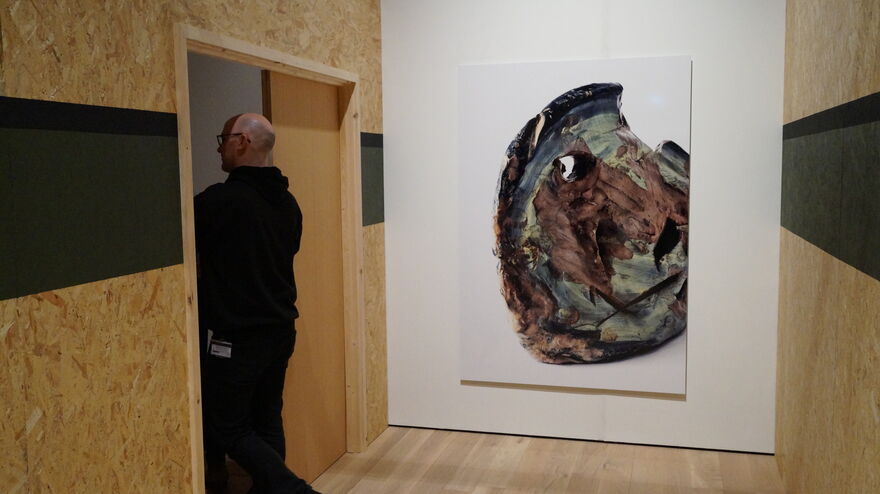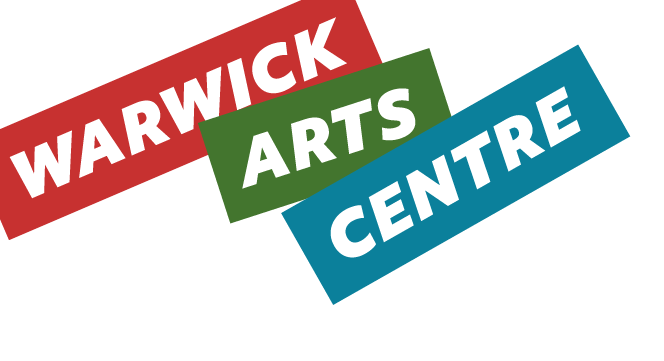
Review of What's Already Going On
Read Artist and Research Associate Lucy Grubb's review of our current Mead Gallery Exhibition.
Wooden doors, and corridors.
Empty space.
Heavy doors.
I see a blob, I turn left.
Wooden doors and corridors.
Katrina Palmer reconstructs the typical University, or at least, the feeling of one.
What door was I supposed to go in? What door was I allowed in? What door would allow my whole to enter?
Were some doors locked? Maybe I was too weak? Maybe I needed to pull? Maybe somebody else could have opened the same door, that I couldn’t?
Maybe I didn’t see all the exhibition – just the cracks and the edges. I was at the edge of a space, and it seemed, at the edge of language.
I was neither in or out, and when I was in, I still felt I was out. Occupying nothing but the cracks between space, what was I trying to find?
Maybe somebody to open the heavy door, so I could sneak my way through.
Walking around these edges, the exhibition reflected the experiences of exclusion, and what it is to be at the edge of a space that doesn’t allow your whole to enter.
This exhibition overlaps the histories of institutional demand, labour, over-thinking, self-building, and theorising.
I am inside but outside; I am confronted by the edges of something that I do not see, but I do feel.
This institutional framework, these wooden corridors with black paint smeared over the walls to cover the pre-existent writing.
Our collective ground for gatekeeping all combine to show the systemic conditions laid upon us within environmental resistances, and impermeable structural constraints.
Placed throughout this exhibition we find paper drawings. The drawings, on lined paper, and marked with marker pen in vertical lines, echo our pathway around the exhibition. Almost like a quasi-map, but a confused one.
The type of scribblings we can find within books, redactions of text, the highlighting of words, and phrases, and the re-inserting of more words as simple reminders for our future selves, all created the drawings that hang on the walls.
Although not linear language, these drawings provided a linear system of being which was followed throughout the exhibition space. The walls in the exhibition, although another redaction, formed a redrafted pathway.
At the back wall, eight TV screens play surveillance tapes of Katrina Palmer learning to throw knifes at some mashed up forms of clay in an office.
There is a permeability here – for all the exhibition gives, we now have a gasp of breath from the bodily force of the knifes being thrown into the wet clay on a semi-empty bookshelf.
From the knife, multiple slits are formed in the clay blobs, just like the linear forms in the drawings (my confused map).
Holding the clay, rearranging its structure, poking its centres, and positing its form takes on the material metaphor of institutional rearranging’s and poking’s.
The only writing within this exhibition, “MT21WK1, MT21WK2, MT21WK3, MT21WK4, MT21WK5, MT21WK6, MT21WK7, MT21WK8” transcribed on the eight TV screens are the codes for the eight-week term at one specific University. One way how academic time is measured.
I now wonder the importance of this data-code, and if this exhibition will contribute to the Research Excellence Framework of Katrina Palmers University, and whether it will help the University league boards.
Eight academic weeks of theorising, thinking, over-thinking, supervisions, admin, and drawn-out conversations. All labour, mostly paid, but more of it, unpaid.
The academic term, where these tapes are filmed, address the very real limit of time in academia, and the growing surveillance of our (academic) labour.
These surveillance tapes are not filmed during the day, in work hours. They are filmed at night, in a dark office. Another edge, another redaction, and so another invisibility comes to hold.
This exhibition purposely redacts its text (to signify a movement away from the artists past work), but leaves in the academic timeframe that the knife throwing was learnt in.
There is an important reminder here – these tapes don’t just hold onto eight weeks of learning and time limits; they amplify the surveillance of our labour.
Importantly how this can, is and will be traced back to codes and bias data systems that have been constructed from outdated pedagogical targets, research frameworks, and academic league boards.
Surveillance of our labour, time-management, and the University’s ability to control what information we can search for on their WIFI, all combine to impact the way we use, act, and think within institutional sites of demand.
When the knife throwing goings into the ninth week, if it ever did, would this be classed as academic work, would the ninth week go into the Research Excellence Framework?
Katrina Palmers work holds narratives that activate when we are present within them, when our bodies take up the space the work is placed in.
This work acts as a provocation that the University still promotes empty space, heavy doors, and long corridors which continue to present access issues (including physical) for many marginalised peoples.
We must constantly ask ourselves, why do we continue to work within these spaces, and how can we make these spaces work for us?
An example which comes to my mind is Nubia Way (1990s) - a black-led self-building housing project. This project came as a resistance to discriminatory policies that were implemented by many local authorities[1].
There is a purposeful nod through this exhibition to past histories of self-building to resist and deconstruct the injustice placed on our bodies and ways of existing.
For this exhibition, Katrina Palmer rebuilds the hallways of the University, in her own terms, in relation to her bodily gestures, and access.
Katrina Palmer fundamentally demonstrates and viscerally questions the University’s perimeters at its very core – she lets us in, only to understand where the dust settles and how dark the edges can become.
The architectural structures that are presented in this exhibition, although self-built, already exist in other forms throughout many institutions, and will continue to exist, even after we leave.
Katrina’s work comments on our potential ability to use and disrupt these spaces. This disruption is seen again, as I leave the exhibition.
Looking through black slits I see the surveilled blobs of slashed clay from MT21WK1,2,3,4,5,6,7,8, but now instead, I am staring at those blobs through the black slits.
There is a resistance here - I just want to touch something that I can’t reach. Another disruption will happen on the 12th March, when this show, and paper, and walls will be knocked down, scrapped, and archived.
Something I won’t see but can only imagine. I leave the exhibition through a disused fire door – the alarm doesn’t go off, but if it did…. just like this current body of work, you don’t need something written down to know what’s already going on.
Thoughts by Lucy Grubb.
Recent News

Things to do in Coventry this April
Enjoy plenty of fun activities right here at Warwick Arts Centre this April. For fun things to do in Coventry, look no further than our amazing selection…

Easter at Warwick Arts Centre
Enjoy dinosaur adventures, an Oscar winner and free activities.

Does your pet dog have what it takes to be an opera star?
Renowned opera company issues a call-out for a local pooch to appear in forthcoming production of La Bohème at Warwick Arts Centre.
